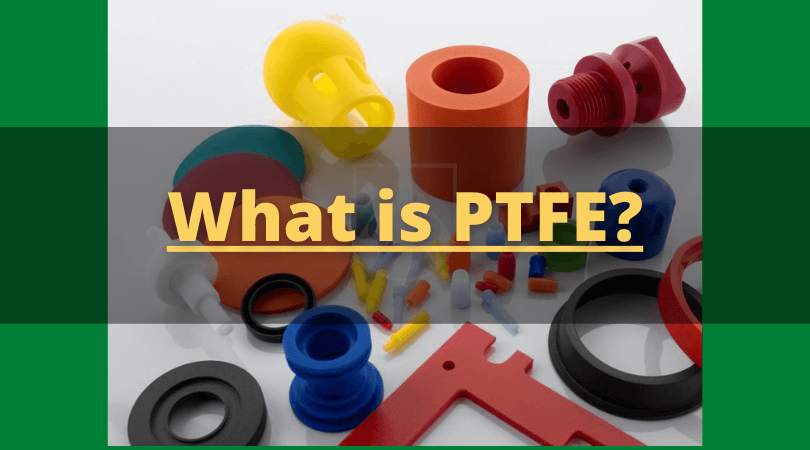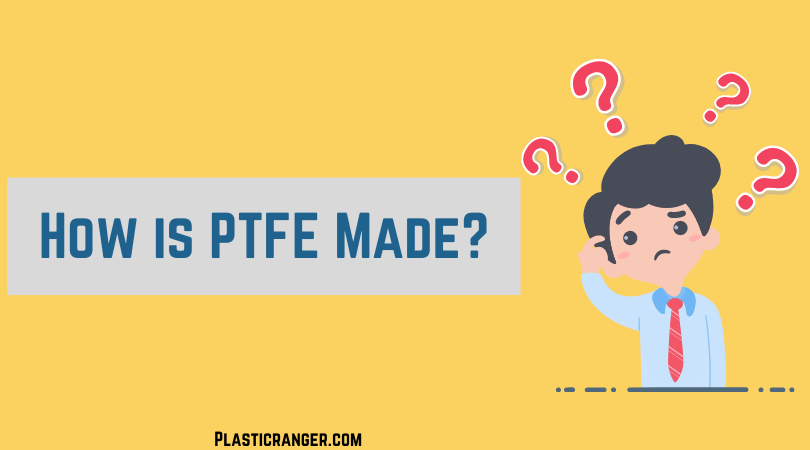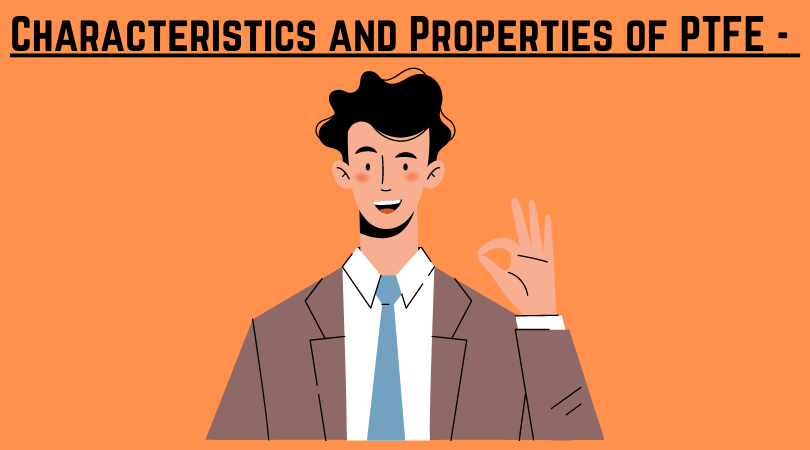Greetings, everyone; I have a wealth of information to impart on polymers. Specifically, today I will be presenting a detailed guide on ABS plastic. Without further ado, let’s begin.
PTFE Material
PTFE, or polytetrafluoroethylene is a high-performance and versatile fluoropolymer comprising carbon and fluorine atoms. A fluoropolymer is a group of plastics offering various properties and benefits. PTFE is one such fluoropolymer, and its discovery reformed the fluoropolymer group forever and paved the way for several applications.

One of the typical applications for PTFE material includes non-stick coatings for kitchen cookware. Thanks, to its non-reactive nature, partly because of the strength of carbon-fluorine bonds, it is often utilized for making pipeworks and containers for reactive and corrosive chemicals. ts is also used in industries such as automobile, electrical, electronics, etc
How is PTFE Made?

The making of PTFE or Teflon is quite similar to any other polymer. It is manufactured by the free-radical polymerization technique in an aqueous media using the addition polymerization of TFE in a batch process.
The chemical structure of PTFE is identical to polyethylene; the only significant difference is that the hydrogen atoms are entirely replaced by fluorine. However, the preparation methods for PE and PTFE are drastically different.
The size of the fluorine atom is huge, forming a uniform and continuous sheath around carbon-carbon bonds, providing good chemical resistance, electrical inertness, and stability to the molecule.
The Interesting History of PTFE

Like many other great discoveries, PTFE was found accidentally. Roy J. Plunkett first discovered it in 1938. At the time, he was working in New Jersey for Dupont.
Plunkett’s original purpose was to make a new chlorofluorocarbon refrigerant. However, the tetrafluoroethylene gas in its pressure bottle stopped flowing before the bottle’s weight had gone to the point signaling “empty.”
However, as Plunkett measured the amount of gas used by weighing the bottle, he became interested in the source of the weight and finally decided to split the bottle apart.
He found the bottle’s interior coated with a white waxy and slippery material. Later it was named polymerized perfluoroethylene, and the iron from the container’s inside acted as a catalyst.
The new material was patented by Kinetic Chemicals in 1941 as new fluorinated plastic and registered the Teflon trademark in 1945.
Fast forward to 1961, when the first US-made PTFE-coated pan was marketed in the United States as “The Happy Pan.”
Since then, there has been no looking back, and non-stick cookware has been one of the most common household products produced by thousands of manufacturers and available worldwide.
Interesting Read – What is Acrylic Plastic?
Characteristics and Properties of PTFE

PTFE is mainly available in three forms – granule, water-based dispersions, and fine powder.
- The granular PTFE materials are produced by suspension polymerization in an aqueous medium with a meager or no dispersing agent. The granule PTFE material is mainly used in compression, isostatic, and ram extrusion methods.
- Water-based PTFE dispersions using the same aqueous polymerization using more dispersing agents with agitation. Water-based dispersions are mostly used in coatings and film-casting methods.
- Fine powder PTFE is small, white particles made by controlled emulsion polymerization. Fine PTFE powders can be processed into thin sections by paste extrusion or additives to improve wear resistance.
Other salient properties of PTFE are excellent high and low heat resistance, electrical insulation properties, chemical inertness, low coefficient of friction (static 0.08 and dynamic 0.01), and non-stickiness over a wide range of temperatures (260 to 260°C).
- PTFE is one of the most reliable materials in terms of chemical resistance. It is only attacked by molten alkali metals, organic halogenated compounds like chlorine trifluoride (ClF3), oxygen difluoride (OF2), and gaseous fluorine at high temperatures.
- The mechanical property of PTFE is also impressive but interior to other engineering plastics at room temperature. The addition of fillers has been proven as a successful way to overcome that obstacle. In its normal temperature range, PTFE exhibits some beneficial mechanical properties. Those properties are also hindered by processing variables such as sintering temperature, preform pressure, cooling rate, etc. Polymer attributes like molar mass particle size and particle size distribution can negatively impact mechanical properties.
- Polytetrafluoroethylene has outstanding electrical insulating properties, low dielectric constant, and insulation pressure. The very low dielectric constant (2.0) results from a sophisticatedly symmetric structure of macromolecules.
- PTFE material also shows good thermal properties without apparent degradation below 440 °C.
- It is also attacked by air degradation and radiation, which begins at a dose of 0.02 Mrad.
Below is a table showing the general properties and values of PTFE.
| Property | Unit |
| Melting Temperature (°C) | 320 to 340 |
| Elongation at Break (%) | 300-550 |
| Tensile Modulus (MPa) | 550 |
| Surface Energy (Dynes/g) | 18 |
| Dynamic Coefficient of Friction | 0.04 |
| Dielectric Constant | 2 |
| Refractive Index | 1.35 |
| Dielectric strength (kV/mm) | 19.7 |
| Appl. Temperature (°C) | 260 |
Engaging Read – What is TPU Material
Disadvantages of PTFE Material
The traditional PTFE material doesn’t come without some drawbacks. Here are they:
- Creep and abrasion sensitive
- It can’t be processed in molten state methods, and the suitable methods can often be unconventional and expansive.
- Joining difficulties
- High dimensional variation around glass transition temperature.
- Low radiation resistance
- Corrosive and prone to toxic fumes.
Importance of Fillers and Additives for PTFE
Adding fillers and additives can significantly improve PTFE’s mechanical properties, specifically creep and wear rate. Typical fillers are steel, carbon, glass fiber, carbon fiber, graphite, bronze, and steel.
Glass Fiber: Its addition will improve PTFE’s creep performance and wear attributes by affecting its low and high temperatures. Furthermore, Glass-filled compounds perform exceptionally well in oxidizing environments.
Carbon Fiber: Carbon fibers are essential in lowering creep, raising hardness, increasing flex, and compressing modulus.
The PTFE blended with carbon fiber compounds has high thermal conductivity and a lower coefficient of thermal expansion.
Carbon fiber is inert to strong bases and hydrofluoric acids (Glass fiber can withstand both). These parts are perfect for making automotive parts like shock absorbers.
Carbon: Carbon as an additive will help reduce creep, increase hardness, and improve the thermal conductivity of PTFE. The same results can be achieved by blending PTFE and graphite, elevating carbon-filled compounds’ wear resistance.
These blends are ideal for non-lubricated applications like piston rings found in compression cylinders.
Bronze-filled PTFE: This compound exhibits outstanding thermal and electrical conductivity making it ideally suited for applications where apart is subjected to extreme loads and temperatures.
Fabulous Read – 6 Best Plastic Molding Techniques | A Complete Analysis
Advantages of Incorporating Fillers
- Fillers/additives are crucial for increasing the porosity of PTFE compounds and thus affect electrical properties – they decrease the dielectric strength while increasing the dielectric constant and dissipation factor.
- Fillers can improve the properties of PTFE substantially in both high and low temperatures.
- The changes in chemical properties can highly depend on the type of additive used, but. in general, it also leaves positive results.
PTFE Applications
Fluorinated thermoplastics are generally utilized for high-performance applications with high heat, high purity, low temperatures, chemical inertness, non-sticking, and self-lubricating properties. Below are some of the most common PTFE uses:
Engineering – bearing, non-stick surfaces, seats, plugs, fittings, valves, and pump parts.
Medical – heart patches, cardiovascular grafts, ligament replacement.
Chemical Industry – pumps, diaphragms, impellers, Coatings for heat exchangers, autoclaves, reaction vessels, tanks, containers, etc.
Automotive – valve stem seals, shaft seals, gaskets, O-rings, linings for fuel hoses, power steering, transmission, etc.
Electrical & Electronics – flexible printed circuit boards, electrical insulation, etc.
Best Techniques to Process PTFE
PTFE’s rigid polymer chain structure makes it extremely difficult to process conventional methods like injection molding and extrusion. Still, its very high melting viscosity and melting temperature also don’t help. Processing technologies, ideally dealing with powder metallurgy, are well suited for PTFE.
- Sintering, compression molding, pressing, ram or paste extrusion, hot stamping, machining, and extrusion of pre-sintered powders on special machines.
- Paste extrusion blends PTFE with hydrocarbons and fabricates it into tapes, tubes, and wire insulation. The hydrocarbon will vaporize before the part is sintered.
- Operating range -200°C to 260°C.
Engaging Read – What is PVDF (Polyvinylidene Fluoride) | A Detailed Guide
The Future of PTFE Material
According to a leading market research company ResearchAndMarkets, the global polytetrafluoroethylene market will see a CAGR of 5.13% during the forecast period of 2019-2024.
However, the road will be full of hurdles because of the Covid-19 pandemic. As of writing this piece, the world has re-opened after a prolonged lockdown, and a vaccine is also making the world rounds.
Still, the prolonged shutdown effect will be long felt as the global economy is seeing its worst economic recession in the history of humanity.
It’s not all doom and gloom; as the vaccine has been made and people are getting vaccinated rapidly, things can catch up faster than anticipated. The same can be said about the PTFE market, let alone the plastic processing industry.
The key to rapid growth lies in the Asian market; China is already the world’s largest consumer of PTFE and still has immense growth potential.
Apart from China, countries like India, Indonesia, Japan, Korea, and Bangladesh hold significant potential for future growth thanks to rising household incomes and favorable government policies to trim down the economic adversities caused by the Covid-19 pandemic.
FAQs
Is PTFE carcinogenic?
It has been proven that PTFE is toxic to human health because it contains a carcinogenic substance called PFOA. However, there is no need to worry as PTFE non-stick coatings no longer include that substance.
What is PTFE tubing used for?
PTFE tubing is most commonly used as laboratory tubing, where chemical resistance and purity are the most important. PTFE has an extremely low coefficient of friction and is known as one of the most “slippery” substances known.
What type of plastic is PTFE?
PTFE is a thermoplastic polymer belonging to a fluoropolymer made up of carbon and fluorine atoms.
What are PTFE sheets used for?
PTFE sheets are used in various applications, such as PTFE envelope gaskets and PTFE packings. It has an exceptional ability to resist gases, water, chemicals, fuels, and oil.
Is PTFE FDA approved?
PTFE is FDA approved and thus used in the food processing and service industry as insulators and bearings.
Suggested Read –
- What is LDPE? | Low-Density Polyethylene | The Complete Guide
- What is Nylon? | Different Types of Nylon | How is Nylon Made? | Key Properties | Applications
- What is TPV Material? | A Simple and Detailed Guide
- What is TPE Material? | The Definitive Guide
- What is PETG Material? | The Definitive Guide
- What is PEEK Material? | A Simple and Detailed Guide
- What is UHMW Plastic Material? | The Definitive Guide
- What is PET Plastic | PET Characteristics | PET Copolymers | How is PET Made | Advantages & Disadvantages
Final Thoughts
In conclusion, Polytetrafluoroethylene (PTFE) is a high-performance plastic distinguished by its exceptional chemical resistance, low friction, and wide temperature tolerance. Best known by the brand name Teflon, it is used in diverse applications, ranging from non-stick cookware to aerospace components.
Its inertness makes it ideal for use in corrosive environments, but the production process involving perfluorooctanoic acid (PFOA) raises environmental concerns.
Newer manufacturing methods aim to mitigate these issues. PTFE’s unique properties make it indispensable in modern engineering and materials science.
Thanks for reading. Kindly share your thoughts in the comment box.
Have a Fantastic Day.
Quick Navigation

Thanks for this guide to what PTFE is. It’s interesting to learn that it’s one of the most reliable materials when it comes to chemical resistance. I think that would help make it useful for a wide range of industries and applications.
You are right Michaela, I’ve always thought PTFE is kind of an underdog for plastic materials.